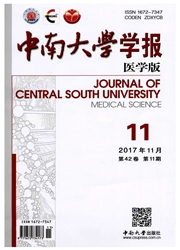

 中文摘要:
中文摘要:
目的:探讨腹膜腔来源的M2型巨噬细胞对糖尿病小鼠同种异体胰岛移植的抗排斥作用。方法:体外分离诱导C57BL/6小鼠腹膜腔M2型和M0型细胞,流式细胞术鉴定巨噬细胞表型。链脲佐菌素(streptozotocin,STZ)诱导C57BL/6雄性小鼠的糖尿病模型作为受体,分离BALB/c小鼠胰岛细胞移植于C57BL/6糖尿病小鼠左肾包膜下。将移植后糖尿病小鼠随机分为3组,每组8只。于胰岛移植术后1,3,7 d分别经尾静脉输注PBS(islet+PBS组)、2.5×106个M0型巨噬细胞(islet+M0组),2.5×106个M2型巨噬细胞(islet+M2组)。移植术后取尾静脉血监测受体血糖水平的变化,记录胰岛存活时间,并于移植后10 d每组随机抽取2只小鼠处死取左肾做病理学检查,观察移植物形态结构和胰岛素表达水平。结果:Islet+PBS组、islet+M0组和islet+M2组移植物的中位存活时间分别为6.5(4~10),7.5(4~10)和24(﹥15)d;与islet+PBS组和islet+M0组比较,islet+M2组移植物调节血糖正常水平时间和中位存活时间明显延长(P〈0.01)。病理学检查结果显示islet+M2组胰岛移植10 d后移植物结构完整,胰岛素染色阳性;而islet+PBS组和islet+M0组胰岛移植物均被排斥,胰岛素染色阴性,局部见大量淋巴细胞浸润。结论:腹膜腔来源的M2型巨噬细胞能减轻受体对胰岛移植物的免疫排斥反应,延长胰岛移植物的存活时间,从而提高受体对血糖的耐受能力。
 英文摘要:
英文摘要:
Objective: To explore the possibility of using peritoneal alternatively activated M2 macrophages to prevent rejection after islet allotransplantation in a murine model. Methods: Peritoneal monocytes from C57BL/6 mice were induced and modulated to M2 and M0 macrophages in vitro, then the phenotype ofmacrophage was assessed by flow cytometry. C57BL/6 mice were induced diabetic by streptozotocin (STZ) injection and transplanted with islets isolated from BALB/c mice under the left kidney capsule. The recipients were randomly divided to 3 groups (n=8). A total of 2.5x106 M2 macrophages were injected intravenously at 0, 3, 7 d after transplantation in islet+M2 group; 2.5x 106 M0 macrophages were injected intravenously at 0, 3, 7 d after transplantation in islet+M0 group; the mice in islet+PBS group were injected with PBS. Blood glucose was monitored after transplantation. On day 10 after transplantation, 2 recipients in each group were randomly selected and sacrificed, and the left kidneys were resected for pathological examination. Results: Achievement of euglycemia was significantly prolonged after islet transplantation in the islet+M2 group than that in the other two groups (P〈0.01). The median survival time of islet allografts in the islet+PBS group, the islet+M0 group, and the islet+M2 group were 6.5 (4-10), 7.5 (4- 10), and 24(〉 15) d, respectively. Pathological examination also showed that the grafts in islet+M2 group remained an intact structure with positive insulin stain and no apparent lymphocytes infiltration, while the graft was rejected in other 2 groups with negative insulin stain and massive lymphocytes infiltration. Conclusion: Peritoneal alternatively activated M2 macrophages can prevent rejection after islet allotransplantation, prolong the survival time of islet allografts and enhance the tolerance of the recipient to blood glucose in mice.
 同期刊论文项目
同期刊论文项目
 同项目期刊论文
同项目期刊论文
 期刊信息
期刊信息
